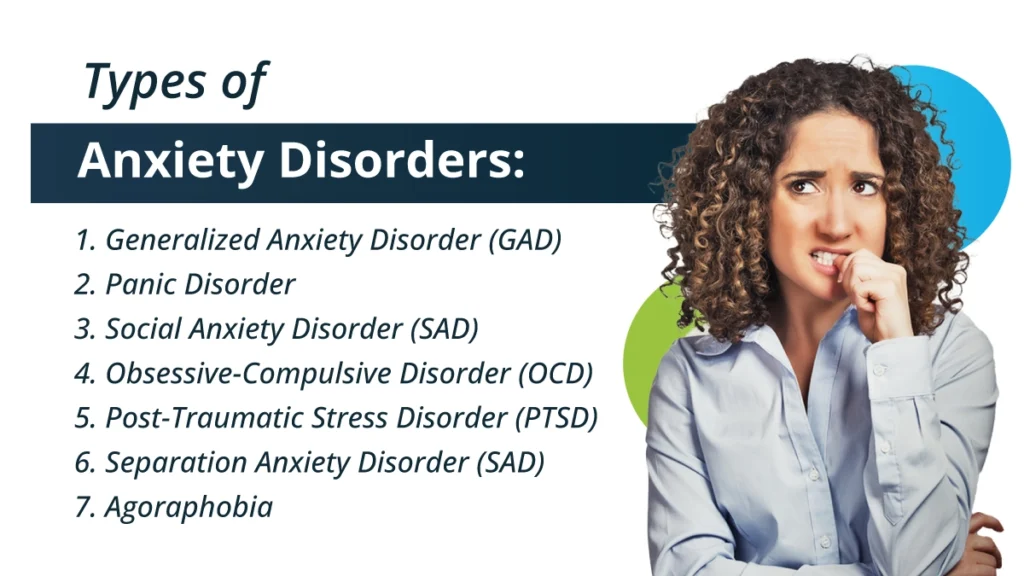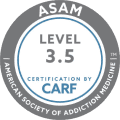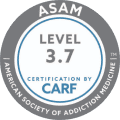Anxiety disorders refer to conditions where individuals experience excessive worry, fear, or nervousness that interferes with their daily lives. These feelings can be overwhelming and persistent, impacting various aspects of a person’s well-being, including their relationships, work, and overall quality of life.
Anxiety disorders are common and can impact anyone, no matter what their age or background. There are different types of anxiety disorders, each with unique characteristics. In this article, we will explore the symptoms, causes, and treatment options related to various anxiety disorders.
Key Takeaways
Anxiety disorders are conditions affecting daily life characterized by excessive worry, fear, and unease. Here is what you need to know:
- Anxiety disorders are of different types, each having unique characteristics and impacts on individuals.
- Anxiety disorders stem from a combination of various factors and manifest in the form of physical and psychological signs.
- Practical treatment approaches for anxiety disorders typically include therapies, medications, and holistic approaches.
For a supportive, evidence-based approach to mental health, contact The Haven Detox-New England at (844) 933-4145.

Generalized Anxiety Disorder (GAD): Chronic Worry
Generalized anxiety disorder (GAD) is a severe condition characterized by excess and persistent worry about various aspects of life, often without a specific cause.
Symptoms of GAD
Common symptoms may include:
- Restlessness and feeling on edge
- Fatigue
- Difficulty concentrating
- Irritability
- Muscle tension
- Sleep disturbances
- Excessive worrying
Causes of GAD
The exact causes of GAD are complex and may involve a combination of genetic, biological, environmental, and psychological factors. Genetics may play a role, as individuals with a family history of anxiety disorders are more susceptible.
Treatment of GAD
Treatment for GAD typically includes a combination of psychotherapy, medication, and lifestyle changes. Cognitive-behavioral therapy (CBT) is often utilized to help those affected manage excessive worrying. Doctors may prescribe meds like selective serotonin reuptake inhibitors (SSRIs) or benzos in more severe cases.
Panic Disorder: Sudden, Intense Anxiety
Panic disorder is characterized by unexpected, recurring panic attacks accompanied by extreme fear and physical symptoms.
Symptoms of Panic Disorder
Common symptoms may include:
- Sudden and intense fear
- Rapid heartbeat
- Sweating
- Trembling or shaking
- Shortness of breath
- Chest pain or discomfort
- Fear of losing control or going crazy
Causes of Panic Disorder
The exact cause of panic disorder is unclear, but a combination of genetic, biological, and environmental factors may contribute. Stressful life events, a family history of panic disorder, and changes in brain function may also play a role.
Treatment of Panic Disorder
Treatment for panic disorder often involves a combination of psychotherapy, medication, and lifestyle changes. Cognitive-behavioral therapy (CBT) is effective in assisting individuals understand and manage panic attacks. Medicines like selective serotonin reuptake inhibitors (SSRIs) or benzodiazepines may be prescribed to ease symptoms.
Social Anxiety Disorder (SAD)
Social anxiety disorder (SAD), also referred to as social phobia, is an intense fear of social situations due to a fear of being judged, embarrassed, or humiliated.
Symptoms of SAD
- Common symptoms may include:
- Intense fear of social situations
- Fear of being scrutinized or negatively evaluated
- Avoidance of social situations
- Physical symptoms such as blushing, sweating, trembling
- Difficulty speaking or making eye contact
- Fear of social interactions leading to significant distress
Causes of SAD
Social anxiety disorder may result from a combination of genetic, biological, and environmental factors. Traumatic social experiences, family history, and an imbalance in neurotransmitters like serotonin may contribute to its development.
Treatment of SAD
Cognitive-behavioral therapy (CBT) is considered to be a primary treatment for social anxiety disorder, helping individuals challenge and change negative thought patterns. Health professionals may also prescribe medicines such as selective serotonin reuptake inhibitors (SSRIs) or benzodiazepines to ease symptoms and support therapy.
Obsessive-Compulsive Disorder (OCD): Intrusive Patterns
Obsessive-compulsive disorder (OCD) is characterized by intrusive, unwanted thoughts (obsessions) and repetitive behaviors or mental acts (compulsions) performed to reduce anxiety.
Symptoms of OCD
Common symptoms may include:
- Intrusive and distressing thoughts or images
- Repetitive behaviors or rituals
- Fear of contamination
- Need for symmetry or order
- Hoarding
- Checking behaviors
- Mental compulsions, such as counting or repeating words
Causes of OCD
The exact cause of OCD is unknown, but a combination of genetic, neurological, behavioral, cognitive, and environmental factors may contribute. Abnormalities in serotonin levels in the brain are also implicated.
Treatment of OCD
Cognitive-behavioral therapy (CBT), specifically exposure and response prevention (ERP), is considered the gold standard for treating OCD. Prescription meds such as selective serotonin reuptake inhibitors (SSRIs) are often prescribed to alleviate symptoms.
Post-traumatic Stress Disorder (PTSD)
Post-traumatic stress disorder (PTSD) develops after exposure to a traumatic event or situation and is characterized by persistent re-experiencing, avoidance, and hyperarousal.
Symptoms of PTSD
- Intrusive memories or flashbacks
- Nightmares
- Avoidance of reminders of the trauma
- Negative changes in mood and thoughts
- Hyperarousal, including difficulty sleeping and irritability
Causes of PTSD
PTSD is typically triggered by exposure to a traumatic event, such as combat, sexual assault, accidents, or natural disasters. The intensity of the trauma, individual vulnerability, and lack of a strong support system can contribute to the development of PTSD.
Treatment of PTSD
Treatment for PTSD often includes psychotherapy, such as cognitive-behavioral therapy (CBT) or eye movement desensitization and reprocessing (EMDR). Prescription meds, including selective serotonin reuptake inhibitors (SSRIs) and antipsychotics, may also be prescribed to manage symptoms.
Specific Phobias: Intense, Irrational Fears
Specific phobias are extreme and irrational fears of specific objects, situations, or activities. Individuals with specific phobias go to great lengths to avoid the feared stimuli, leading to significant impairment in daily functioning.
Symptoms of Specific Phobias
Common symptoms may include:
- Intense fear or anxiety about a specific object or situation
- Immediate and intense anxiety upon encountering the feared object or situation
- Avoidance of the feared object or situation
- Physical symptoms like rapid heartbeat, trembling, and nausea
Causes of Specific Phobias
Specific phobias can develop from genetic, environmental, and learned factors. Traumatic experiences or witnessing others experiencing fear in certain situations may contribute to the development of specific phobias.
Treatment of Specific Phobias
Cognitive-behavioral therapy (CBT), particularly exposure therapy, is a common and effective treatment for specific phobias. Gradual exposure to the feared object or situation helps individuals confront and overcome their fears. Medications are generally not the first-line treatment for specific phobias.
Separation Anxiety Disorder (SAD): Attachment Anxiety
Separation anxiety disorder (SAD) is characterized by excessive anxiety concerning separation from home or from those to whom the individual is attached.
Symptoms of SAD
Common symptoms may include:
- Excessive distress when anticipating or experiencing separation
- Persistent and excessive worry about losing attachment figures
- Refusal to be alone or without attachment figures
- Nightmares about separation
- Physical signs like headaches or stomach aches when separation is imminent
Causes of SAD
Separation anxiety disorder is commonly associated with significant life changes, such as starting school or experiencing a significant family disruption. A combination of genetic, environmental, and psychological factors may trigger it.
Treatment of SAD
Psychotherapy, especially cognitive-behavioral therapy (CBT), is the primary treatment for separation anxiety disorder. Therapeutic techniques focus on addressing and modifying maladaptive thoughts and behaviors related to separation anxiety. In severe cases, medication may be considered.
Selective Mutism: Speech Shyness
Selective mutism, a childhood anxiety disorder, is characterized by a consistent inability to speak in specific social situations despite speaking in other settings.
Symptoms of Selective Mutism
Common symptoms may include:
- Inability to speak in certain social situations
- Consistent avoidance of speaking despite a desire to communicate
- Social withdrawal and reluctance to engage in verbal communication
- Anxiety or discomfort in social settings
Causes of Selective Mutism
The exact causes of selective mutism are unclear, but it often coexists with social anxiety disorder. Genetic factors, temperament, and environmental influences like family dynamics may contribute to its development.
Treatment of Selective Mutism
Behavioral interventions, including systematic desensitization and exposure therapy, are commonly used to treat selective mutism. Speech therapy and the involvement of parents or caregivers in treatment are essential. In some cases, medication may be considered to alleviate anxiety symptoms.
Agoraphobia: Fear of Situations or Places
Agoraphobia is marked by an intense fear of situations or places where escape might be difficult or embarrassing or where help may not be available in the event of a panic attack.
Symptoms of Agoraphobia
Common symptoms may include:
- Avoidance of crowded places or situations that trigger anxiety
- Fear of being alone outside the home
- Reluctance to leave the safety of home
- Panic attacks or intense anxiety when facing feared situations
- Dependency on others for support or companionship
Causes of Agoraphobia
Agoraphobia usually arises as a complication of panic disorder, where individuals begin to avoid situations associated with panic attacks. It can also stem from genetic, environmental, and psychological factors.
Treatment of Agoraphobia
Cognitive-behavioral therapy (CBT) is the most common and effective treatment for agoraphobia. Gradual exposure to feared situations, coupled with cognitive restructuring, helps individuals confront and manage their fears. Doctors may also prescribe medications such as SSRIs or benzos to alleviate symptoms.
Substance-Induced Anxiety Disorder (SIAD)
Substance-induced anxiety disorder (SIAD) is characterized by anxiety symptoms that are a direct result of substance abuse or withdrawal. Certain substances, including drugs and alcohol, can trigger or exacerbate anxiety symptoms.
Symptoms of SIAD
Common symptoms may include:
- Excessive worry or fear
- Restlessness
- Irritability
- Muscle tension
- Sleep disturbances
- Increased heart rate
- Trembling or shaking
Causes of SIAD
The use of substances such as alcohol, stimulants, or sedatives can directly impact brain function and contribute to anxiety symptoms. In addition, withdrawal from certain substances can lead to increased anxiety.
Treatment of SIAD
Addressing the underlying substance abuse issue is crucial for managing substance-induced anxiety disorder. This may involve medical detoxification, residential rehabilitation, therapies like cognitive behavioral therapy (CBT), medications, and ongoing support.
Frequently Asked Questions (FAQ)
Can a person with GAD live a normal life?
Yes, individuals with generalized anxiety disorder (GAD) can lead normal lives with proper treatment approaches and support. Therapy, medication, and coping strategies empower them to manage anxiety, enabling a fulfilling and functional daily life.
What are anxiety disorders, and what causes them?
Anxiety disorders are a group of mental health conditions marked by excessive worry, fear, and unease. Various factors contribute to their development, including genetics, brain chemistry, personality, and life experiences. A combination of these elements can trigger and exacerbate anxiety disorders.
Which anxiety disorders are most common?
Common anxiety disorders may include generalized anxiety disorder (GAD), social anxiety disorder (SAD), and Specific Phobias. These prevalent conditions affect a significant portion of the population in the United States, impacting daily life and well-being.
The Haven Detox-New England: Your Path to Renewal
At The Haven Detox-New England, we understand the weight anxiety disorders carry and want to extend a supportive hand to guide you toward a better future.
In our residential rehab program, experience a nurturing and secure haven where evidence-based therapies, expert medication management, and holistic approaches unite to empower your mental health journey.
We specialize in dual diagnosis support for those grappling with substance use disorders (SUD) along with mental health struggles.
Remember, seeking professional medical help is not a sign of weakness but a courageous step toward reclaiming your life. Contact us at (844) 933-4145, and let our team be your partners in this journey.
Verify Insurance
Let’s get you or a loved one help with a few simple steps.




